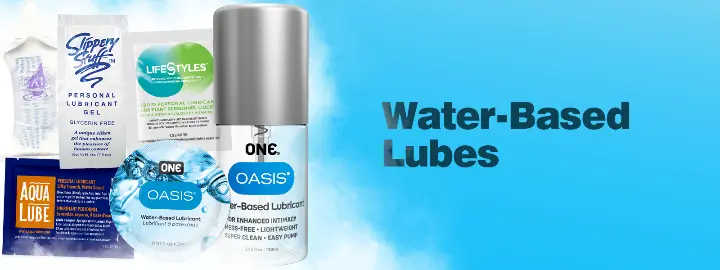Lube is a condom’s best friend. Sharing a little history on personal lubricants, plus the various types.
A Brief History:
People have been using lube for thousands of years! All over the world, people discovered different methods and substances that could be used to reduce friction and enhance sexual pleasure. In 600 BC China, it was extracted from boiling red seaweed. A few hundred years later, Greeks and Romans used olive oil to lube up.
It wasn't until the 17th century that people started to get creative again. In China and Japan, animal intestines were used as condoms and grated yams as lube. By the late 1800s, Vaseline and K-Y surgical jelly was on the market. When word caught on that people were using the surgical version for sex, they manufactured and marketed the first personal lubricant!
In recent years, lube has continued to evolve. There are tons of options on the market, so it can be difficult to find the right one for you!
Fun fact: Personal lubricants are classified as a medical device under the FDA, just like condoms!
Here are the top three lubricant types, all safe to use with latex condoms:
1. Water-based Lubricants
Water-based lubricants are widely popular due to their versatility and ease of use. As the name suggests, these lubes have a water base with additional ingredients to provide a more slippery texture.
The best thing about water-based formulas is that you can use them with a variety of condom materials and toys, including toys made from silicone. They are also easier to clean up and shouldn’t stain your sheets. They do, however, tend to evaporate more quickly than silicone-based lubes, sometimes requiring more frequent application.
![]()
2. Silicone-based Lubricants
Silky-smooth and long-lasting, silicone lubes are great for all sorts of sexual activity. Unlike water-based lubricants, silicone lube won’t absorb into the skin quickly, so a little goes a long way in reducing friction. Silicone lubes tend to have fewer ingredients, so they can be more optimal for those with sensitive skin. They are waterproof and thus ideal for any shower or water-based sex.
Fun fact: Did you know most condoms are lubricated with silicone lubricant?
Silicone lubricants are not recommended to be used with silicone-based sex toys, as the silicone can bind together and deteriorate the surface of the toy. Due to the nature of silicone, a silicone-based lubricant can also stain sheets – so be careful how you apply!

3. Hybrid Lubricants
Hybrid lubes are exactly what they sound like: a blend of silicone and water, with a few other ingredients. The result is a lube that offers the longevity and lusciousness of silicone-based lubricants, with the easy cleanup and sex toy compatibility usually found in water-based lubes. Our ONE® Oasis Silk® personal lubricant is a hybrid lubricant that was specifically developed with sexual health experts to be pH-friendly (more on that below). Oasis Silk can be used during sex or anytime to alleviate vaginal dryness.
About oil-based lubricants:
These lubes can last an incredibly long time without reapplication and are often derived from natural ingredients. Unfortunately, oil-based lubes shouldn’t be used with latex condoms, as oil molecules can deteriorate latex and cause a latex condom to break.
Oil-based lubricants can include products like coconut oil, Vaseline, etc. Enhanced risk for yeast infections has been attributed to oil based lubes. Oil-based lubes also have a risk of staining sheets. Some organic lubes use oil, which is not compatible with latex condoms, so just make sure to check the label before use.
What does it mean for a lube to be pH-balanced?
Different parts of our bodies have different levels of acidity. Vaginal pH usually hovers around 4 and anal pH at a 7. Matching the pH level in lube to your sexual activity of choice can reduce the risk of infection or irritation. It is important to note that pH only applies to water-based lubricants; silicones are inert and do not alter pH. Our ONE® Oasis® water-based lubricant has an average pH of 5.38 and our ONE® Oasis Silk® hybrid lubricant has an average pH of 5.23.
From ancient remedies to store shelves, lube has had quite the evolution. Whether you prefer long-lasting silicone-based lubes, very versatile water-based lubes, or a hybrid option that combines the best of both worlds, there is a personal lubricant out there for you! Remember to choose a lube that is compatible with your body, sex life, and toys or types of condoms you may be using. Lube helps you enter into a whole new world of pleasure!
Global Protection manufactures and distributes a variety of lubricants in bulk quantities and you can see our offering here. The ONE® lubricants are also available for individual sale at onecondoms.com.
